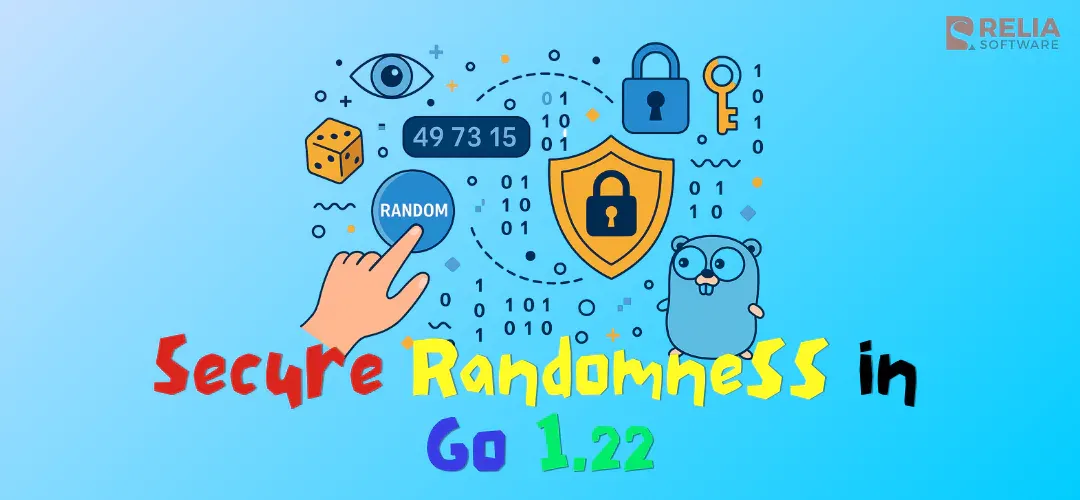In the realm of programming, randomness plays a pivotal role across various domains, from cryptographic security to gaming and simulations. However, not all randomness is created equal.
In contexts where security is paramount, such as cryptographic operations, the unpredictability and security of the generated random values are crucial. This is where secure randomness comes into play, ensuring that random values are not only unpredictable but also resistant to potential attacks.
With the release of Go 1.22, the Go programming language takes significant strides in enhancing secure randomness. This latest version introduces key improvements and optimizations in the crypto/rand package, designed to provide developers with robust tools for generating secure random numbers.
In this blog post, we will explore the importance of secure randomness, the new features in Go 1.22, and practical applications of these advancements.
>> Read more about Golang coding:
- Top 6 Best Golang Testing Frameworks
- Comprehensive Guide for Golang Unit Test with Code Examples
Understanding Secure Randomness
Secure randomness refers to the generation of random values that are both unpredictable and resistant to reverse engineering. This type of randomness is crucial for applications where security is a top priority, as it ensures that the random values cannot be predicted or reproduced by any party, even those with access to the generating algorithm or process.
Importance of Secure Randomness in Cryptographic Applications
In cryptographic applications, the security of the entire system often hinges on the quality of the random numbers used. Secure randomness is essential for:
- Key Generation: Cryptographic keys must be unpredictable to prevent unauthorized access. Secure random numbers ensure the keys cannot be guessed.
- Nonces and Initialization Vectors (IVs): These are used to ensure that the same plaintext encrypts to different ciphertexts, preventing replay attacks and ensuring data integrity.
- Session Tokens: Tokens used in authentication and session management need to be securely random to prevent hijacking and unauthorized access.
Comparison Between Non-Secure and Secure Randomness
Predictability
Non-secure random number generators (RNGs), like those found in the standard library of many programming languages, can produce patterns that might be predictable if the internal state is known. Secure RNGs, on the other hand, are designed to be unpredictable, even if the algorithm is known.
Entropy Sources
Non-secure RNGs often rely on a limited set of entropy sources, which can make them vulnerable to prediction. Secure RNGs use high-entropy sources, such as hardware random number generators or environmental noise, to ensure true randomness.
Use Cases
Non-secure randomness is often sufficient for applications like simulations, games, or simple random selections where predictability does not pose a risk. Secure randomness is mandatory for cryptographic operations, secure token generation, and any application where security breaches could have severe consequences.
What’s New in crypto/rand Package of Go 1.22?
Go 1.22 brings significant enhancements to its crypto/rand package, focusing on improving the performance, robustness, and ease of use for secure random number generation. These improvements ensure that developers can generate truly secure random values efficiently and reliably.
Performance Improvements
One of the key improvements in Go 1.22 is the optimization of the underlying mechanisms used to generate secure random numbers. These optimizations have resulted in faster random number generation without compromising security.
By reducing the computational overhead, Go 1.22 ensures that applications requiring high volumes of secure random numbers can perform better and scale efficiently.
Enhanced Entropy Sources
Go 1.22 has enhanced its use of entropy sources to make the process of generating secure random numbers more robust against potential attacks. The crypto/rand package now better utilizes system-level entropy sources, such as hardware random number generators and environmental noise, to ensure a higher quality of randomness. This improvement reduces the risk of predictability and increases the overall security of the generated random values.
Introduction of New APIs
To simplify the process of generating secure random numbers, Go 1.22 introduces new APIs in the crypto/rand package. These APIs provide more straightforward and flexible ways to obtain secure random values for different use cases. The new APIs are designed to be more intuitive, reducing the likelihood of developer errors and making it easier to integrate secure randomness into applications.
>> Read more about API-related topics:
- What is An API? An Ultimate Guide for API Development
- gRPC vs GraphQL: Choosing the Right API Technology
- Gin-Gonic Tutorial: API Development in Go Using Gin Framework
Implementation of Generating Secure Random Numbers in Go 1.22
To illustrate the use of secure random number generation in Go 1.22, we’ll provide a simple example using the crypto/rand package. This example will demonstrate how to generate a secure random number and handle potential errors.
Explanation of the crypto/rand Package
The crypto/rand package in Go is designed to provide cryptographically secure random number generation. It leverages system-level entropy sources to ensure the randomness is unpredictable and suitable for security-critical applications. This package includes several functions for generating random bytes, integers, and prime numbers.
Detailed Walkthrough of the Code
Here is a code example that demonstrates generating a secure random integer between 0 and 99 using the crypto/rand package:
package main
import (
"crypto/rand"
"fmt"
"math/big"
)
func main() {
// Define the upper limit for the random number
max := big.NewInt(100)
// Generate a secure random number between 0 and max-1
n, err := rand.Int(rand.Reader, max)
if err != nil {
fmt.Println("Error:", err)
return
}
// Print the secure random number
fmt.Println("Secure random number:", n)
}crypto/rand: Provides cryptographically secure random number generation functions.fmt: Used for printing the output.math/big: Provides support for big integers, which are essential for working with large random numbers.
By following this approach, you can ensure that your application generates secure random numbers reliably and handles any potential issues gracefully. This example highlights the simplicity and robustness of using the crypto/rand package in Go 1.22 for secure random number generation.
Practical Applications of Secure Randomness
Cryptography: Secure randomness is crucial in cryptographic applications to ensure the security and integrity of encrypted data. Here are two primary use cases:
Key Generation
In cryptography, keys are used to encrypt and decrypt data. These keys must be unpredictable to prevent unauthorized parties from guessing or deriving them. Secure random number generation is essential in creating these keys.
Example Code for Key Generation:
package main
import (
"crypto/rand"
"fmt"
"io"
)
func generateKey(length int) ([]byte, error) {
key := make([]byte, length)
_, err := io.ReadFull(rand.Reader, key)
if err != nil {
return nil, err
}
return key, nil
}
func main() {
key, err := generateKey(32) // 256-bit key
if err != nil {
fmt.Println("Error generating key:", err)
return
}
fmt.Printf("Generated secure key: %x\n", key)
}In this example, the generateNonce function generates a secure random nonce of the specified length.
Token Generation
Tokens are widely used in authentication and session management to securely identify and validate users. Secure randomness ensures that these tokens are unique and cannot be easily guessed or replicated by malicious parties.
- Secure Tokens for Authentication and Session Management:
Tokens are often used to maintain user sessions and authenticate API requests. Secure random tokens prevent session hijacking and unauthorized access.
- Example Code for Token Generation:
package main
import (
"crypto/rand"
"encoding/base64"
"fmt"
)
func generateToken(length int) (string, error) {
token := make([]byte, length)
_, err := rand.Read(token)
if err != nil {
return "", err
}
return base64.URLEncoding.EncodeToString(token), nil
}
func main() {
token, err := generateToken(32) // 256-bit token
if err != nil {
fmt.Println("Error generating token:", err)
return
}
fmt.Printf("Generated secure token: %s\n", token)
}By leveraging secure randomness for key generation, nonces, initialization vectors, and token generation, developers can enhance the security and integrity of their applications, protecting sensitive data from security risks. The crypto/rand package in Go 1.22 provides robust tools to achieve these security goals efficiently.
Conclusion
Secure randomness is crucial in various applications, from cryptographic key generation and secure token creation to nonces and initialization vectors for encryption. The unpredictability and robustness provided by secure random number generation are fundamental to protecting sensitive data and preventing unauthorized access.
To maximize the benefits of these enhancements, it is essential to follow best practices:
- Always use
crypto/randfor security-critical operations. - Handle errors gracefully to maintain the integrity and security of your applications.
- Stay updated with the latest Go releases to benefit from ongoing security improvements and new features.
By adhering to these best practices, Golang developers can ensure their applications are secure, reliable, and ready to meet the challenges of modern software development. The enhancements in Go 1.22's secure randomness capabilities are a testament to the language's commitment to security and performance, making it a strong choice for developers worldwide and their Golang projects.
>>> Follow and Contact Relia Software for more information!
- golang
- coding
- development
- Mobile App Development

